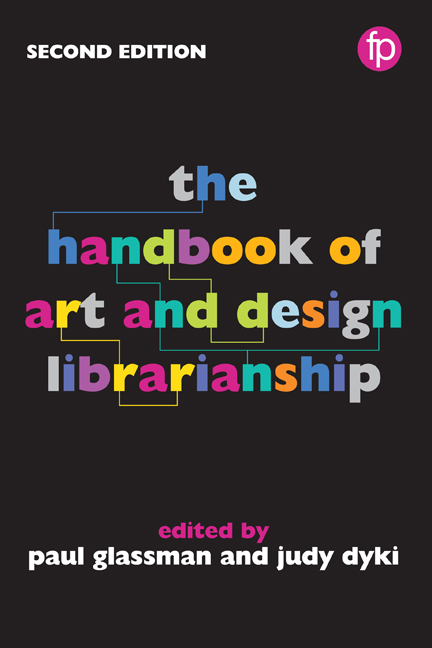Book contents
- Frontmatter
- Contents
- List of figures and tables
- Notes on contributors
- Foreword
- Preface
- Part I Roles and responsibilities
- Part II Materials and collection management
- Part III Teaching and learning
- Part IV Knowledge creation
- 21 The ever-shifting landscape: mapping the present and future of digital art histories
- 22 Critical cARTography: mapping spaces for dialogue about identity and artistic practices
- 23 More than just art on the walls: enhancing fine arts pedagogy in the academic library space
- 24 Beyond the monograph? Transformations in scholarly communication and their impact on art librarianship
- Part V The physical environment
- Part VI Promotion and sustainability
- Appendix Library profiles
- Index
22 - Critical cARTography: mapping spaces for dialogue about identity and artistic practices
from Part IV - Knowledge creation
Published online by Cambridge University Press: 08 June 2018
- Frontmatter
- Contents
- List of figures and tables
- Notes on contributors
- Foreword
- Preface
- Part I Roles and responsibilities
- Part II Materials and collection management
- Part III Teaching and learning
- Part IV Knowledge creation
- 21 The ever-shifting landscape: mapping the present and future of digital art histories
- 22 Critical cARTography: mapping spaces for dialogue about identity and artistic practices
- 23 More than just art on the walls: enhancing fine arts pedagogy in the academic library space
- 24 Beyond the monograph? Transformations in scholarly communication and their impact on art librarianship
- Part V The physical environment
- Part VI Promotion and sustainability
- Appendix Library profiles
- Index
Summary
Introduction
One of the most exciting aspects of digital mapping projects is their ability to speak to users and facilitate discussion. In many ways, printed maps can do the same thing. If you take a historical map of a city that shows population density and place it in front of a group of students or community members, it will not be long before a discussion begins on neighbourhood change, migration patterns, or visualization techniques and methods. In her introduction to Infinite City: a San Francisco atlas, Rebecca Solnit writes that ‘every place is if not infinite then practically inexhaustible’ (Solnit, Pease and Siegel, 2010, 2). As a result, maps provide a framework for interpretation, discussion and reflective thinking. In many ways, academic librarianship, much like a map, is rooted in providing information to an audience. The mechanism for this exchange of information is multifaceted, and it can occur in a classroom, within collection development policies, at the reference desk, in a research guide, or during an online chat. This chapter asks, ‘Why not use a map?’
The digital map-making process is one method for librarians to experiment in providing access to information and sharing that information to a wide audience of users. As digital humanities-based research becomes more prevalent in academia, how can librarians leverage some of the methods and tools used to create our own digital projects to advance emerging literacies and reframe our library collections for new audiences? Moreover, as we develop partnerships with faculty in the classroom, how can we become engaged in pedagogy that helps not only add value to, but also shapes a syllabus? The results of a recent international survey that asked questions of art and design librarians in higher education pointed to emerging tasks that ‘relate to online communication and services’ and concluded that ‘librarians might serve as guides who create original information and direct users to supplemental resources’ (Carpenter et al., 2010, 22, 27).
In the following pages, we hope to expand on this finding by discussing two mapping projects that point to and highlight existing resources and offer a way for users to reinterpret these collections for their own research.
- Type
- Chapter
- Information
- The Handbook of Art and Design Librarianship , pp. 225 - 230Publisher: FacetPrint publication year: 2017

